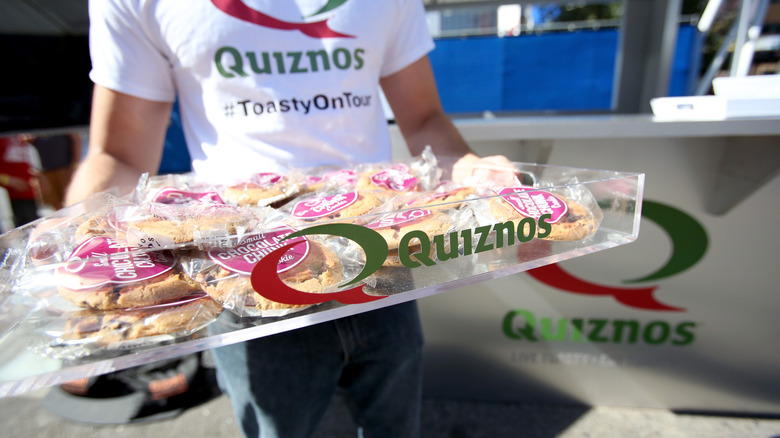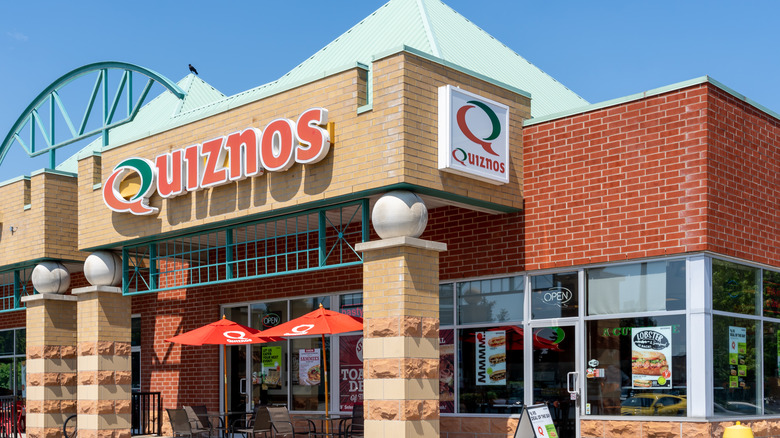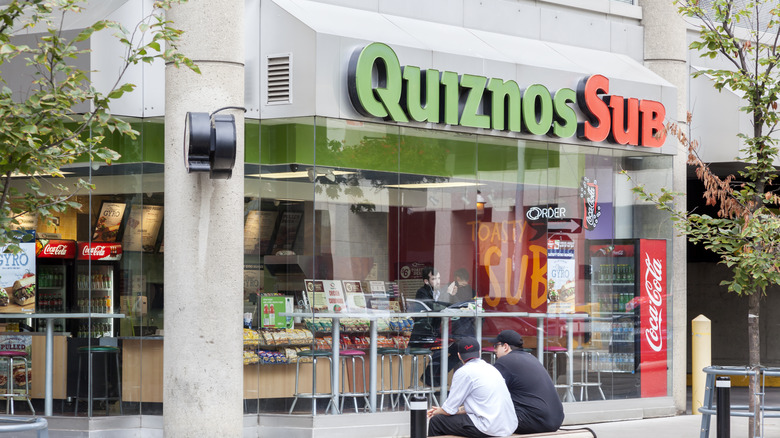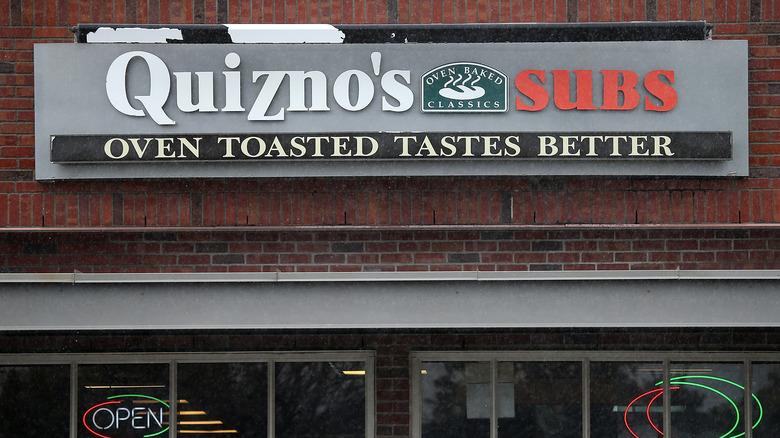What Actually Happened To Quiznos?
We all know the name of the One Sandwich Chain to Rule Them All in America and beyond; Subway has dominated the fast food sandwich game for decades, at one point actually having more restaurant locations than mighty McDonald's. True, there are now lots of other contenders for the fast food submarine throne, like Firehouse Subs, Jersey Mike's, Blimpie, and Penn Station — but none can topple the might of Subway.
But those who grew up in the 1990s and 2000s will remember that once, there was a chain that — at least for a time — genuinely looked like a threat to Subway's sandwich dominance. That chain was Quiznos, the restaurant that brought the conveyor toaster to prominence, even forcing Subway to toast their sandwiches (albeit badly) for the first time ever. Their rapid rise from 1991-2013 showed that maybe, the unbeatable juggernaut was beatable after all.
And then it just ... seemed to vanish from the face of the Earth. So how did it happen? What led to the downfall of Quiznos? It turns out it wasn't just one factor but a colossal mess of ill-advised decisions and worse luck that ultimately doomed the brand in quite possibly the most rapid downfall in chain restaurant history. And it all started with a business model that seemed predisposed to failure.
Quiznos was built on a rickety foundation
Quiznos was created as a brand in 1981 by Jimmy Lambatos, but it wasn't until 10 years later in 1991, after being sold to Rick and Richard Schaden, that it really took off. The Schadens jumped the brand from 18 locations to 4,700 in the span of 20 years; by 2006, it trailed only Subway for dominance in sandwich sales in the United States.
That's when things started to fall apart. The core issue was a simple one: The entire business model of Quiznos was built on a house of cards, and franchisees had been sold a bad bill of goods when buying in. The company made profit largely by selling food and branded products (like wrappers) to their own franchisees; it was how it expanded so rapidly in the first place. But their subsidiary distribution system, under American Food Distributors, sold to franchisees at such high prices that the only way locations would be able to make money was by raking in sales. Since a franchise's average revenue was only around $400,000 per year, that wasn't happening.
In 2006, the dam finally burst when the franchisees started suing them for fraud, treating them as "captive customers" under their distribution system. One even took his own life after the company terminated his franchise agreement for trying to help organize his fellow franchisees for the lawsuit. And that was only the start of the trouble for Quiznos.
Subway hit Quiznos right where it hurt
Sensing weakness after Quiznos' highly-publicized issues, Subway pounced, installing toasters and discounting prices; this is where the famous $5 footlong deal (which it dropped in 2018 after Quiznos was no longer a threat) originated. The big mistake Quiznos made was trying to compete in kind, because suddenly, those expensive ingredients meant owners were making even less profit than their already razor-thin margins.
The problem was, in order to attempt to keep themselves afloat, Quiznos had engaged in a leveraged buyout shortly after the lawsuits. The details are complicated, but the topline takeaway is that suddenly the company had cashflow — but it also had massive debt. The idea under a leveraged buyout is that a company has to keep growing to deal with this issue, and that's exactly where Quiznos failed. Things got worse and worse, and the acrimony with franchisees wasn't going away. In 2009, corporate sent out free sandwich coupons. Franchisees were so angry they refused to honor them, and the whole thing turned into another PR mess.
But by that time, the chain had bigger problems: the Great Recession of 2008 hit a lot of companies hard, but maybe none harder than Quiznos. Franchises started closing left and right; 1,500 closed from 2008-2010 alone. By 2017, the company only had 400 locations left, having tumbled off a cliff from that 4,700 peak. And that wasn't the end of Quiznos terrible luck.
Quiznos got bad PR and made it worse
The company was also still losing the PR battle. In some cases — like with the franchisees' lawsuits — this was a disaster of its own making, but there were others it couldn't have predicted. In 2006, the company's senior VP of marketing, Scott Lippitt, was arrested after attempting to solicit an undercover police officer he thought was a 13-year-old girl. Incredibly, Quiznos made a bad situation worse by not immediately firing him (though it did do so eventually). But the fallout reached forward through time when in 2009, the company launched a truly bizarre ad campaign involving a toaster sexually harassing Quiznos employees. The public relations firestorm that occurred over a three year-period from the lawsuits, the sex scandal, the suicide, and the awful advertising (that brought back up the sex scandal) was a cataclysm from which there could be no going back.
By 2013, the writing was on the wall; Quiznos was a sinking ship, and in 2014, it filed for bankruptcy. It attempted a comeback as a fast casual chain with alcohol in 2015, but it went nowhere. There were buyouts in both 2016 and 2018 as new corporate overlords tried to right the sinking ship, only to realize it was unsalvageable. As of October 2023, less than 150 U.S. Quiznos locations remain. Never again (at least not to date) would a chain challenge Subway's dominance. RIP, chicken carbonara sub; we hardly knew ye.



